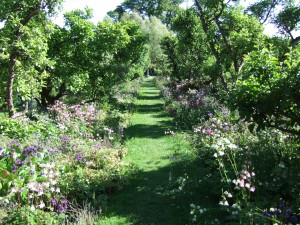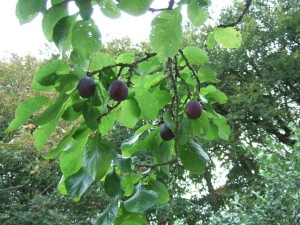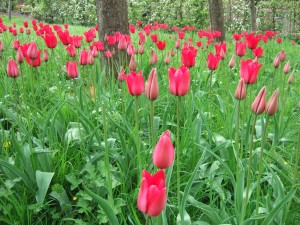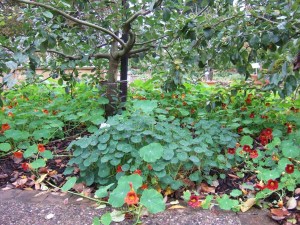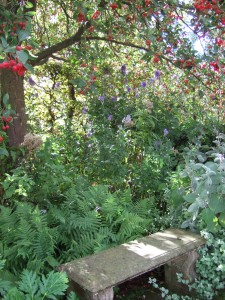Make an orchard garden
Most of us don’t have the kind of wealth that would allow us to be big landowners, so we can’t have our own woodland. But if we’ve got an ordinary garden we can have the next best thing, an orchard garden, like a garden version of a hedgerow harvest.
Of course most of us still don’t have a big enough garden for a whole orchard of large fruit and nut trees. Even those of us with gardens only a few metres long and wide, though, can have at least one small almond tree or hazel, or a fruit tree – apples, pears, plums, cherries and more – on a dwarfing rootstock.
If we’ve got a bit more space then we can have fruit on more vigorous rootstocks, or bigger fruit or nut trees like mulberries and walnuts.
So why fruit and nut trees rather than other trees? And why trees at all? Well, trees because they’re big and beautiful, they’re bigger than we are and they live longer, so they can give us a sense of perspective. But from the point of view of climate, trees shelter our gardens from the sun and from the wind, so that the soil is protected and kept at that Goldilocks state, not too dry, not too wet, but ‘just right’: moist and rich in carbon.
And orchard trees – fruit and nuts – not just because we can get delicious health-giving food right where we live, but also because that way we can reduce food miles and greenhouse gas emissions, and because nuts are a tasty and nutritious alternative to meat and cheese and other animal foods, which have a bigger greenhouse gas footprint than plant foods. In the United Kingdom, food accounts for about a fifth of our greenhouse gas emissions, according to Tara Garnett of the Food Climate Research Network.
We’re used to thinking of orchards as rows of trees with just grass underneath them. If that’s what we want, fair enough: lawn maintenance usually means a lot of greenhouse gas emissions, but if we allow the grass to grow longer, if we cut it less often, and if we allow clover and other non-grass species to share space with the grasses, then we need feel no shame when we enjoy one of life’s greatest pleasures – lying on the grass in an orchard.
But an orchard garden can be more varied, and the more varied it is, and the more layers it has, then the better chance we have to make our gardens as productive as possible, and therefore the more carbon dioxide our gardens will absorb and the more carbon our gardens can store.
Indeed, the convention of ‘grassing down’ orchards is a relatively new one which only took off recently in Britain: until the middle of the twentieth century British orchard-growers used to cultivate the soil between the trees with ploughs or hoes. Cultivation disturbs the soil and reduces soil carbon, so it’s not good for the climate.
Instead, and especially if we space our orchard trees more widely than in true commercial orchards so that more light gets through, we can grow all sorts of other plants below and between the trees. This is the idea of ‘forest gardens’, first described in Britain by Robert Hart, and more recently by Ken Fern, Patrick Whitefield, and by Martin Crawford.
(Many people would call my orchard gardens ‘forest gardens’, but I prefer to call them ‘orchard gardens’ instead, because the word forest suggests to me something scary and dangerous from a Grimms’ fairy tale, or a gloomy spruce plantation, or even – as Oliver Rackham points out – a Forest with a capital F, a king’s hunting ground.)
So as climate-friendly gardeners we can
- have a garden of plants and soil rather than a garden that’s full of buildings and paving;
- plant a wide network of fruit and nut trees, with open glades between them;
- add ground-cover plants below the trees (and organic mulch to protect the soil until the plants reach full cover);
- add other plants to create several layers.

